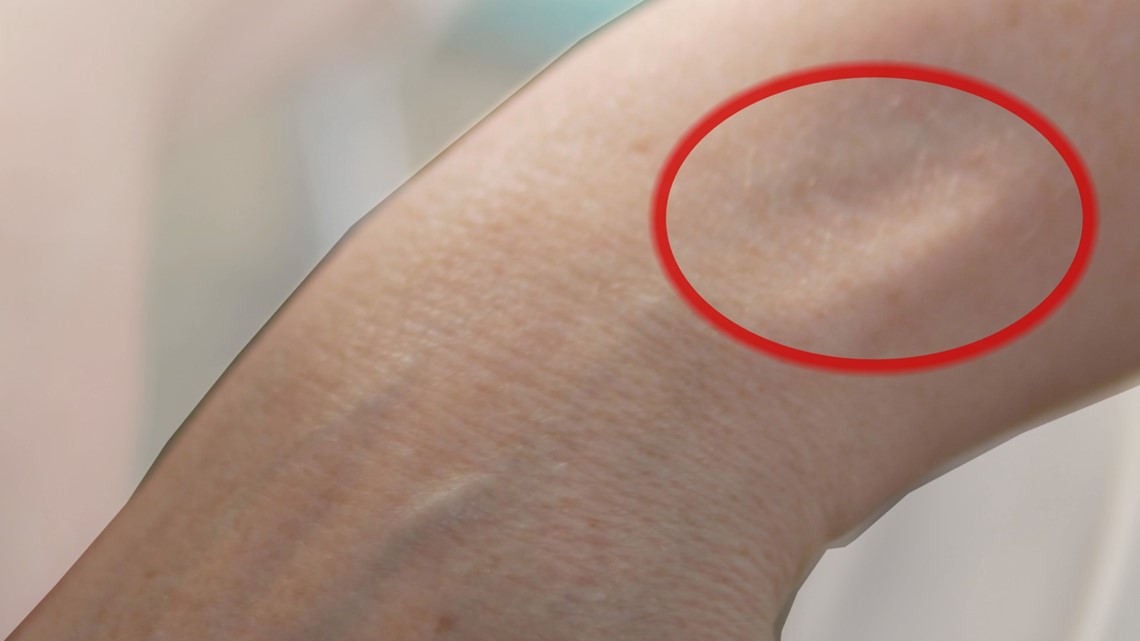JACKSONVILLE BEACH, Fla. — They're designed to keep you healthy by tracking your calories, your steps and your sleep habits.
“I wanted to track my progress and see how much activity I really did each day,” Sherry Glaser said. She wore a fitness tracker for more than a decade but recently noticed a dent in her wrist.
“Through here, it's definitely a dent. You can feel the bones and the tendons very easily in this one spot,” Glaser said. “I took it off one afternoon, and I was charging it. And I actually just looked down, and I was paying attention to my wrist. And I thought wow, what is this dent that I have? And so, I jumped on the internet and started looking around and realized that a lot of people have noticed the same type of dent.”


She didn’t find anything scientific, but a lot of chatter on blogs and wondered if it was caused by Bluetooth.
“It would be readily syncing with a Bluetooth connection for maybe hours at a time. And I think that is where the issue started to come into play,” Glaser said.
Glaser reached out to us to get answers. She wanted to know if she had done any lasting harm.
We took her questions to Dr. Chris Goll with Southeast Orthopedic Specialists. He specializes in hands and wrists. We asked him about the so-called wrist dent.
“I wouldn't say it's the most common thing that we see, but patients come in and they mention that they've got wrist symptoms,” Dr. Goll said. “Sometimes they relate that to objects they're wearing or activity trackers or watches or bracelets or things.”
He says wearing your device too tight can cause compression.
“A lot of these devices now don't need to be removed as frequently,” Dr. Goll said. “And so, there's really no break or no rest even to the structures underneath them.”
And that he says can cause what appears to be a dent.
“It typically is not permanent,” Dr. Goll said. “What happens is with focal compression over any tissue, you can create a little defect in that tissue, or you can kind of change the growth of that tissue underneath.”
Glaser says it's not the dent that concerns her the most.
“It's more about what has it done to my bone, my tissue, long term?” Glaser said. “My question is has anybody said to people not to sync it while you're wearing it and the constant radiation as the Bluetooth is engaged? How healthy is that for a person?”
According to the Centers for Disease Control and Prevention, wearable technology typically uses low-powered radio frequency or RF transmitters to send and receive data and exposes the user to very small levels of RF radiation over time.
Devices sold in the U.S. that transmit this type of radiation can’t exceed exposure limits set by the FCC in 1996. But there is pressure on the agency to revisit those standards, since these devices have become ubiquitous over the last 26 years.
“They're based on short-term exposures for protecting against heating only, not for long-term, daily, chronic low-level exposure,” Theodora Scarato, Executive Director of Environmental Health Trust said.
She says the constant exposure, especially among children, demands more scrutiny.
“We have been calling on the FCC to review all of the science because there are hundreds of studies. In fact, thousands of studies that show effects at very low levels,” Scarato said.
Dr. Goll says studies have shown this type of radiation does not cause cellular damage.
“There is no good evidence that that radiation or that those Bluetooth or Wi-Fi signals are causing any long-term damage,” Dr. Goll said.
Although he doesn’t think we need to worry about RF radiation from a wrist device, he does have a suggestion if you wear one.
“Loosen it, and remove it,” Dr. Goll said. “If you can get a finger or two underneath your device, you'll still get good readings. And it should be able to move up and down. So that if there is a little rough edge on that, or if there is a little pressure spot, it's not always on the exact same tissue.”
Glaser still has the dent nearly two months after she stopped wearing her fitness tracker and for now plans to keep it off.
In response to our questions, the FDA sent First Coast News a statement:
“Bluetooth devices and cell phones both emit radio frequency (RF) energy, a type of non-ionizing radiation. Based on the evaluation of the currently available scientific information, the FDA has determined that the weight of evidence continues to demonstrate that there is no link between exposure to radio frequency energy from the use of cell phones or smart watches/fitness trackers and any health problems at or below the radio frequency exposure limits set by the FCC.”
The CDC directed us to the FCC. We reached out to the FCC multiple times but never received a response.

